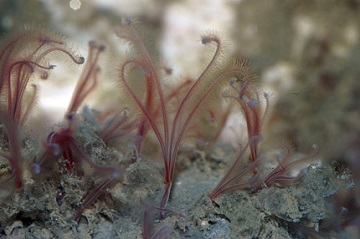371115-bone worms.jpg

Bone worms bore into bones of whale carcasses. Credit: Greg Rouse, Scripps Institution of Oceanography
When a whale dies, its carcass is a massive buffet for bottom-dwelling organisms. They can strip the bones bare in a matter of months. But the feast doesn’t end there. Tiny worms feed on the bones themselves, carpeting the skeleton in what looks like a giant feather boa.
The first of these bone worms were discovered in 2002, a couple of miles deep off the coast of California. Another dozen or so species have been found since then, in both the Pacific and Atlantic oceans.
Their bodies are pink tubes an inch or two long. They’re topped by feathery stalks that contain gills. But most of the bone worm lives inside the bones. It extends “roots” into the bone, like the roots of a plant. The roots contain bacteria that consume the oil and fats that make up a large percentage of the whale’s bones. The worm itself lives off these bacteria, although biologists haven’t figured out just how that happens.
In most of the species discovered so far, the visible worms are all female. The males are tiny, and live inside the body of a female -- about 50 to 100 males for every female. But a species reported in late 2014 is different -- the males are about as big as the females.
When the worms have extracted all the nutrition from a skeleton -- usually of a whale, but sometimes from other large mammals or fish -- they die off. By then, they’ve sent thousands of eggs or larvae into the water. A few of them will survive long enough to find a new skeleton -- a new buffet for these odd little bottom feeders.

